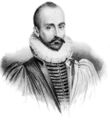Template:Selected anniversaries/February 28: Difference between revisions
No edit summary |
No edit summary |
||
| Line 21: | Line 21: | ||
||1792: Karl Ernst von Baer born ... naturalist, biologist, geologist, meteorologist, geographer, and a founding father of embryology. He was a pioneer in studying biological time – the perception of time in different organisms. Pic. | ||1792: Karl Ernst von Baer born ... naturalist, biologist, geologist, meteorologist, geographer, and a founding father of embryology. He was a pioneer in studying biological time – the perception of time in different organisms. Pic. | ||
||1820: Dr William Bird born ... surgeon and chemist known for his discovery of Herapathite. Pic search. | |||
||1825: Joseph Thomas Clover born ... doctor and pioneer of anaesthesia. He invented a variety of pieces of apparatus to deliver anaesthetics including ether and chloroform safely and controllably. By 1871 he had administered anaesthetics 13,000 times without a fatality. Pic. | ||1825: Joseph Thomas Clover born ... doctor and pioneer of anaesthesia. He invented a variety of pieces of apparatus to deliver anaesthetics including ether and chloroform safely and controllably. By 1871 he had administered anaesthetics 13,000 times without a fatality. Pic. | ||
Revision as of 12:24, 13 April 2020
1533: Philosopher and author Michel de Montaigne born. He will be one of the most significant philosophers of the French Renaissance, known for popularizing the essay as a literary genre.
1552: Clockmaker and mathematician Jost Bürgi born. He will be recognized during his own lifetime as one of the most excellent mechanical engineers of his generation.
1901: Chemist, biochemist, peace activist, author, and educator Linus Pauling born.
1961: Codebreaker, historian, academic, and alleged time-traveller Florence Newman Trefethen discovers new class of Gnomon algorithm functions which use high-energy literature sensors to analyze the form and function of poetry.
2017: Steganographic analysis of excerpt from "Burglars" unexpected reveals "at least half a gigabyte of encrypted data, probably related to the ENIAC program".




